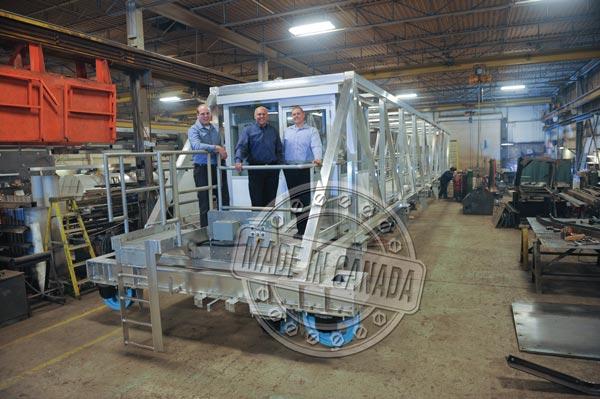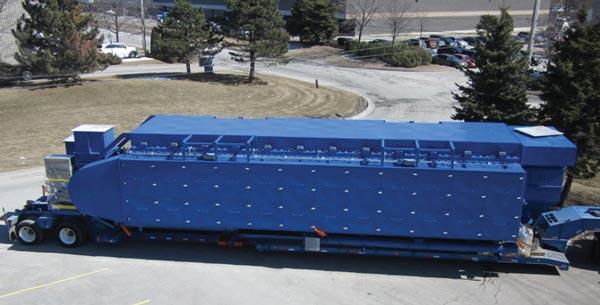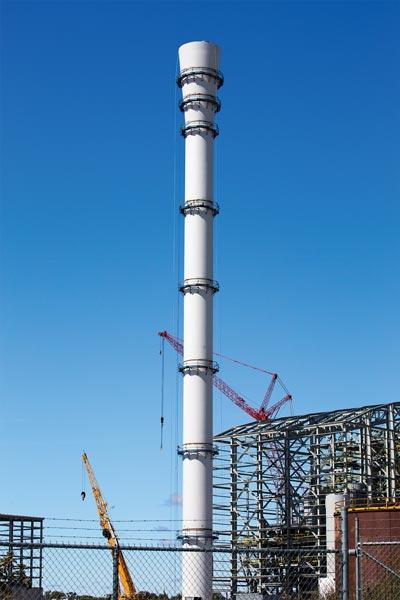- FMA
- The Fabricator
- FABTECH
- Canadian Metalworking
Open Atmosphere, Kith and Kin Secure Company Future
D&R Custom Steel Fabrication structures serve environmental OEMs
- By Sue Roberts
- June 16, 2014
- Article
- Made In Canada

D&R Custom Steel Fabrication’s (left to right) Dan Engelage, business manager; Fred Engelage, president; and Chris Boers, production supervisor, stand aboard an aluminum bridge in one of the two fitting bays.
D&R Custom Steel Fabrication in Pickering, Ont., is a family affair; actually, multiple generations from two families that own and operate the company, plus the extended family that embraces 60 employees. Then there are the blue-chip design and engineering companies in the environmental, mining, and equipment industries, selected and pursued to join the family as customers and long-term business partners.
D&R started small. John DeWit and Yke Reitsma, immigrants from the Netherlands, founded the company in Markham, Ont., in 1971 after learning the steel fabricating trade in their new home country.
Fred Engelage, current president, joined D&R in 1998 and became a partner with Yke’s son, Charlie, in 1999. Keeping family succession going, Charlie’s nephew and Yke’s grandson, Chris Boers, production supervisor, and Fred’s son, Dan Engelage, business manager, now share in the ownership.
“We have a successful business model,” Dan said. “We’ve had a couple of tough years due to unexpected market fluctuations caused by the economy, but we learned from those years and are doing a better job of managing the business. During the last recession our sales dropped like everybody else’s, but we still made a small profit and avoided layoffs. Our customers stuck with us even though other companies were knocking on their doors and offering unreasonably low prices to try to keep their own doors open.”
Choosing Core Customers
Most customers have been with D&R for more than 20 years, with a few celebrating a 35th anniversary. Large, multinational corporations providing equipment to the water/wastewater, air treatment, conveyance, and mining industries comprise most of the customer base.
Projects typically involve large custom fabrications in carbon steel, stainless steel, and aluminum. Some jobs include the challenge of working with exotics like Hastelloy® and AL-6XN®.
“We developed a 10 core customer list and focused on bringing them in,” said Fred. “Each represents about 10 percent of our business, each one in a little different industry to keep us busy when a market goes flat. Two years ago, 60 percent of our work was for the mining industry. Right now mining is probably only 10 percent, but the municipal water/wastewater and air treatment industry has taken up the slack.
“The owners of D&R choose environmental equipment because it is a good industry. It does great things for the world. It’s not glorious like building rockets and may not always be the most profitable, but it is steady work. Our employees get a steady paycheck, and we all feel good about the end result.” Many customers were hand-picked because their business practices fit with D&R’s business philosophy.
“A lot of shops are what we call project-specific. They get a contract for $2 million, complete the project, and then don’t have anything to do. Our philosophy is to keep at least 30 jobs on the go at one time so if one job gets slow, we have something to back it up. The advantages are that we are never slow and our guys get experience doing different things, which is interesting for them,” Fred added.
Chris said, “We always have a sense of urgency on the plant floor with another job ready to go. Without this sense of urgency, jobs tend to drag on and can quickly become unprofitable.”
Opening Communications
When Fred left a senior management position at a large Japanese corporation to join D&R, he found a successful company with the more traditional top-down management style. Fred contributed his international management experience and initiated practice of the Japanese principle of kaizen (continuous improvement), based on team involvement. As part of kaizen implementation, company business updates, plans, and strategies are shared and discussed with all employees at quarterly meetings. The meetings build trust and provide a comfortable venue for feedback and suggestions.
One of D&R’s guiding principles, based on an Albert Einstein quote, fits well with the kaizen philosophy: “Insanity is doing the same thing over and over again and expecting different results.” Everyone at D&R is encouraged to try new processes and procedures to gain better, and different, results for customers and the company.
Talking from his desk in an open office environment, Fred said, “We avoid management silos in the office. If everybody is closed in his own office, it is hard to be aware of all that is going on. I might look at a situation and ask our purchaser something without leaving my desk or overhear a conversation and easily add some needed information. Things generally do not fall through the cracks. The downside,” Fred added with a laugh, “is that you don’t always want to be part of the conversation.”
Empowering the People
A lunch-and-listen program invites two employees at a time to lunch with Fred and either Chris or Dan. The management team listens to their ideas on how to reduce costs, improve productivity, and enhance the work environment.
“We have heard some great ideas—things we had never thought about,” said Fred. “We’ve implemented 75 percent and they’ve really made a difference. We believe our employees appreciate being listened to. They don’t feel like mushrooms.” One idea, building inspection platforms for the 12 overhead cranes in the three bays of the 26,000-sq.-ft. shop, saved time and improved safety by eliminating the need for balancing on a ladder during the inspection process.
An incentive program, designed to encourage employees to look out for each other, keeps a focus on safety. The number of lost-time accidents has dropped from a dozen a year to one or two. Every 25 working days without a lost-time injury generates a reward. “We do things like serving Tim Hortons coffee and doughnuts at break time, bringing in pizza for lunch, and distributing gift cards to local restaurants when a major milestone is achieved,” Fred said.
Profit sharing is another program that serves both the employees and the company. On average, two weeks’ pay is added to everyone’s annual salary.
“With our fairly flat management structure, we need our employees to, in effect, supervise each other. When they participate in the company profits, they look for ways to make the company more profitable because they know that some of the money is going back in their own pockets,” said Fred. “They don’t want anyone wasting time. They are much more engaged in helping the company succeed.”
Creating Their Own Workforce
The company doesn’t have problems hiring tradespeople. If it has a need for a fitter or welder, it enrolls an employee in an apprenticeship program through the University of Ontario Institute of Technology in Oshawa. Chris identifies a promising shop laborer who has the right work ethic, attitude, and raw skills to become a welder or fitter. This person is then enrolled in the apprenticeship program.
The educational effort is an investment for the company, but the owners say the results are “fantastic.” Everyone who has been offered the opportunity has accepted it. Currently four welders and two fitters are going through the three-year program with more to come.

This large dust collector is being shipped to Mexico. Photo courtesy of D&R Custom Steel Fabrication.
“A few years ago we found that some of the older welders had good physical skills but didn’t know why they were doing what they were doing or what to do if they got into a difficult situation,” said Fred. “They didn’t fully understand the chemistry of what they were welding. Today some of our apprentice welders do some of the better work. They have gone to school and understand the principles and theory behind welding. We invest in them and in return we get quality work and loyal, knowledgeable employees.”
Upping Productivity With New Equipment
New equipment cropped up in nearly every area of the shop in 2013.
“The combination of government programs that allow an accelerated depreciation for equipment purchases and the fact that our employees identified areas where we needed to increase productivity and quality resulted in a significant number of investments,” said Fred.
The company completely refurbished its ESAB high-definition plasma table, one of the first of its kind installed in Canada according to Chris. “We have all new cutting software, machine controllers, mechanical parts, and precision hole technology. Cutting speeds are about 30 percent faster.”
A 1970s-era three-roll plate roll was complemented with a new four-roll model capable of rolling 102-in. by 5⁄8-in. material and cone bending. The Akyapak AKBEND plate roll is positioned in a new production cell along with a new profile roll from the same OEM. “We used to move the roll to the job and the fitter did the rolling,” said Fred. “It became an efficiency and safety issue. So we dedicated an area of the shop to the new equipment and have one roll operator. It increased the efficiency and safety of the process and the overall rolling quality.”
Five-year-old forklifts that had a tendency to break down were another issue. “We can’t have a truck sitting on the street waiting for loading. Somebody has to pay for that time,” said Dan. The solution was adding a new Caterpillar 12,000-lb.-capacity truck to the fleet.
“The guys on the brake were having issues. Sometimes the pieces would be a little offset. The crown affected the fit and finish so the fitters were spending time making things work and it was costing us money,” said Dan. “As a result, we bought a 440-ton, full CNC Ermak brake that has about 10 percent more capacity than the old one. It includes anticrowning technology and the latest safety features which meet CSA requirements. With the new CNC technology, the pieces we are bending are perfect.”
Testing the Equipment
A series of Lincoln welding equipment went from prototype to production on the D&R shop floor. “We were the first company in the area to adopt the new pulse MIG welding technology,” Fred said. “We were doing some stainless steel welding that had a cosmetic issue. Lincoln application engineers came in to see what we could do. We tested new equipment that we ended up buying and sent our people to their school to learn how to use it to its best advantage.”
Although the majority of machining is outsourced to three local shops, the in-house drilling that was done was creating a bottleneck. Capacity was bumped up with the elimination of some old equipment, the refurbishing of an existing drill, and the addition of a new 48-in. radial arm drill.
A new structure was also part of the 2013 investment. Chris said, “Everything has to have special blasting, special epoxy paints where you have to meet all kinds of standards. So we installed a sandblasting hut where we aren’t reliant on weather conditions. It gives us good quality control and it’s environmentally better.”

These float cells used in the processing of minerals were shipped to a mine site in western Canada. Photo courtesy of D&R Custom Steel Fabrication.
Planning for Tomorrow
The future of D&R looks bright as it transitions to the next generation. Core values which have provided steady growth over 43 years are firmly in place. “Our goal has been, and continues to be, satisfying our customer needs to the best of our ability,” said Dan. “We believe that if our customers are satisfied with our service and products, they will continue to come back.”
Investing in new equipment and technology, upgrading employee skills, and soliciting feedback from customers and suppliers will continue to drive the company forward. “The demand is there to double the size of our company if we want to,” Fred said. “The challenge is managing that growth while maintaining the personal touch with our employees and customers.”
Photos by Richard Bell Photography unless otherwise noted.
subscribe now


Keep up to date with the latest news, events, and technology for all things metal from our pair of monthly magazines written specifically for Canadian manufacturers!
Start Your Free Subscription- Trending Articles
- Industry Events
ZEISS Quality Innovation Days 2024
- April 15 - 19, 2024
Tube 2024
- April 15 - 19, 2024
- Düsseldorf, Germany
CTMA Economic Uncertainty: Helping You Navigate Windsor Seminar
- April 30, 2024
- Windsor, ON Canada
MME Winnipeg
- April 30, 2024
- Winnipeg, ON Canada
CTMA Economic Uncertainty: Helping You Navigate Kitchener Seminar
- May 2, 2024
- Kitchener, ON Canada
















